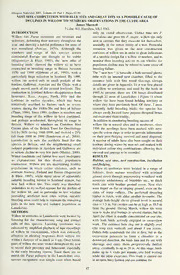
Nest-site competition with blue tits and great tits as a possible cause of declines in willow tit numbers: observations in the Clyde area PDF
Preview Nest-site competition with blue tits and great tits as a possible cause of declines in willow tit numbers: observations in the Clyde area
GlasNgEoSwTNa-tSurIaTliEstC20O0M2.PVEoTluImTeI2O4.NPaWrtI1T.PHagBesL4U7E-50TITSANDGREATTITSASAPOSSIBLECAUSEOF DECLINESINWILLOWTITNUMBERS:OBSERVATIONSINTHECLYDEAREA JamesMaxwell 7LilacHill,Hamilton,MLS7HG INTRODUCTION only on visual observation. Unlike blue tits P. Willow tits Parus montanus are resident and caeruleusandgreattitsP.major,willowtitsonly sedentary,defendingtheirterritorythroughoutthe nestincavitiesthattheyexcavateforthemselves, year,andshowingahabitatpreferenceforareasof normallyintherottenstumpofatree.Particular wet woodland (Perrins, 1979). Although the attention was given to the nest construction numbers and range of this species across activitiesofwillowtitsinordertogleanindications continental Europe are thought to be stable ofasuitabledesignforawillowtitnestbox,andto (Hagemeijer & Blair, 1997), the ‘new atlas of monitortheirbreedingactivitytoseewhetherthe breeding birds’ showed the willow tit to have populationdeclinemayberelatedtosomecauseof contracted inbreedingrange inBritainbetween breedingfailure. 1970 and 1990 (Gibbons etal., 1993), with a The“nestbox“isbasicallyabark-coveredplastic particularlylargereductioninScotland.By 1990, tubewithaninternalnestchamber,filledtothe willow tits nested only in small pockets ofthe entrance hole with fine wood shavings (design borders,Galloway,AyrshireandtheClyde,witha detailsaregiveninAppendix1);itwasfirstplaced singlerecordnorthofthecentrallowlands.This inwillowtitterritoriesandusedbythebirdsin contractioninScotlandfollowsdisappearancefrom 1995.Atpresent,thereare 136boxesdistributed Inverness, Ross, Angus, Perth, Fife and the through22areasofLanarkshire(Figure1)where Lothians in earlier decades, which has been willowtitshavebeenfoundholdingterritoryor tentatively ascribed to factors such as severe wheretheyhavepreviouslybred.Ofthese,7areas wintersduringthe 1940s-50sandlossofhabitat currently hold breeding birds; the species has (Thom,1986).Since1990,declinesinnumbersand alwayseasilyjocatedthesepurpose-designedboxes breedingrangeofthewillowtithavecontinued, andexcavatedthemreadily^ andperhaps accelerated,throughoutitsrangein Inadditiontomonitoringbreedingsuccessof Britain. Willow tit numbers on Common Bird willowtitsinnaturalsitesandinnestboxes,since CensusplotsoftheBritishTrustforOrnithology 1996thenestlingshavebeenmarkedwithnest- fellby56%during1988-1998,andshoweda29% specificcolourringsinordertoprovideinformation fallfrom 1998to 1999(Sandersonetal.,2000). ontheirpost-fledgingsurvivalandnataldispersal. Lanarkshire is now the northern limit for the Anumberofadultshavealsobeencaughtontheir species in Britain, and the neighbouring small territoryduringwinterbymistnetandmarkedwith isolatedpopulationsinAyrshireandGallowayare individualcolourringcombinations,allowingtheir inseriousdeclinetoveryfewpairs(Murray,2000). survivalandpairingstoberecorded. Winterconditionsandhabitatlossseeminadequate RESULTS as explanations for this drastic population Habitat,nestsites,nestconstruction,incubation contraction.Willowtits are maintaininghealthy andfledging. populations in much colder climates, such as Willowtitterritorieswere locatedinarangeof northernNorway,FinlandandRussia(Hagemeijer habitats, from mature woodland with minimal & Blair, 1997),whilemany areasofapparently groundcoverthroughregeneratingwoodlandwith suitablebreedinghabitatinScotlandremain,but moderate understorey ofbrambles etc.,to thick now lack willow tits. This study was therefore birchcarrwithheathergroundcover.Nestsites undertakentotrytofindreasonsforthedeclineof werefoundonflatorslopingground,evenonthe the willow tit,andinparticulartotestwhether sides of steep valleys. The preferred decaying providing artificial nest sites within suitable timberisbirch,withalderanotherfavourite.The breedingareascouldhelptomaintaintheremaining averagehole-heightabovegroundlevelinnatural pairsinthenowtinyandisolatedpopulationin sitesis1.5m,butcavitiescanbeashighas10.5m LMaEnaTrkHsOhiDreS. fsereonmttohmeagkreoutnrdia.lbDourriinnggsiMnarscevhe,rawlisltluomwpst,itsbuwterbye WillowtitterritoriesinLanarkshirewerelocatedby Apriltheeffortisusuallyconcentratedononesite, listeningforthe characteristic song andcontact with both birds actively engaged in excavation calls of this species. Locating territories was work.Theentranceholedugoutisslightlyoval enhancedbyamplifiedplaybackoftaperecordings (the long axis vertical) and about 3 cm across. ofwillowtitvocalisations,whichwasextremely Debrisfallsunderneaththesiteatfirst,butasthe effective inelicitingresponses from willow tits excavation proceeds to form a chamber in a withinadistanceofasmuchas1km.Oncefound, downwarddirection,thebirdsturnandflyoutwith pairsofwillowtitswerevisitedthroughouttheyear shavings and carry them progressively further torecordtheirpresenceandbehaviour,especially away,eventuallytoupto20m.Atthisstage,birds intheearlybreedingseason.Sincethereareno makeupto4visitsperminute,onebirdwaiting marshtitsParuspalustrisintheLanarkshirearea, whiletheotherexcavates.Thisworkiscarriedout speciesrecognitionwassimpleevenwhenbased inanopen,busyfashionandcancontinuefor 47 Figure1.Locationsofwillowtitterritoriesinvestigatedon theR.Clydesystemduringthestudyfrom 1994-2001: l=StrathclydeCPark,Motherwell;2=CalderGlen,EastKilbride;3=Baron’sHaugh,Motherwell;4=ChatelheraultCpark, Hamilton;5=Candermoss,Stonehouse;6=GarrionGillfoot,Overtown;7=Mauldslie,Rosebank;8=RossTip,Hamilton; 9=Harestonehill,Newmains;10=EastmuirPlan.,Newmains;ll=UpperClyde,NewLanark;12=MillburnGlen,Larkhall; 13=Merryton, Larkhall; 14=Cleghorn Glen, Lanark; 15=Jock’s Gill, Carluke; 16=Greenhead Wood, Waterloo; 17=DrumpellierCpark,Coatbridge;18=ColtnessWoods,Coltness;19=AuchterWater,Newmains;20=GarrionGillhead. Overtown;21=UpperMillbum,Ashgill;22=Canderwood,Stonehouse. several days. When the cavity is complete,the produced14young.Fivepairswerelocatedin femalethenbuildsaminimalnest-afelt-likepad 1998,producing28young.In1999,twopairswere offinehairs,grassesandfibres.Sheincubates,and successfulinnaturalstumps,producing14young. isfedonthenestbythemale,butoccasionally In2000thereweresixpairsproducing47young leavestheeggsunattended,concealingthemwith (twopairsinnestboxes,fourinnaturalsites),andin ruffled nest material. Both parents share chick- 2001,threepairsinnaturalstumpshad17young.A feedingdutiesandwhentheyoungfledge,theyare fourthpairatColtnessusedaboxtothenesting dependent for about a fortnight, then gradually stagebutthendeserted(seefurthernote).Sightings disperse. ofunringedbirdshintedattheexistenceofother Useofnestboxes,andbreedingdata breedingpairsintheareabutthereareprobablyno The “nestbox “ (Appendix 1) has proved very morethan8-20pairsofwillowtitsnowremaining successful,andisregularlyadoptedbywillowtits. inLanarkshire. In 1996, 5 young fledged from a nest box at Sitefidelityanddispersal StrathclydeCountryParkandapairheldterritoryat Acolourringedmalewillowtithasbredatthe Baron’s Haugh. In 1997,two pairs bred in the samesiteatEastmuirPlantation,Newmains,each WishawandLanarkareas,bothinnestboxes,and yearforfoursuccessiveseasons,buteachseason 48 withadifferentfemale.Youngbirdsgivensite- DISCUSSION specific colourrings were found establishing a In coldercountries such as RussiaandFinland, territory,onaverage,onlyabout1-2kmfromtheir youngbirdsusuallyjoinadultsinadjoiningareas natalsite.InLanarkshire,themainstrongholdof andcapitalize,inthewinter,onfoodthattheolder willow tit breeding is in the areacentering on birds have stored (Cramp & Perrins, 1993). In Newmains,WishawandColtness,withothersites Lanarkshire,storingfoodseemsnottobesovital, nearLarkhall.Onefledglingtravelled6kmfrom andyoungstersareoftenfoundholdingterritories Coltness to a site atBaron’s Haugh. From one ontheirowninthepost-natalyear.Willowtitsin broodof9chicksatLarkhall(in2000),onemoved Lanarkshireseemrarelytojoinwintermixedflocks toBaron’sHaugh(5km),onetoWishaw(4km), oftits,butremainintheirterritorythroughoutthe onetoGarrionGill(3km)andonemoved2km,all year.Thedispersalofjuvenilesfromtheirnatal indifferentdirections.TheGarrionGillfemalehas territorytoestablishingaterritoryofonlyafew bred(in2001)withapreviouslydispersedmale hundredmeterstoafewkilometresawayistypical birdfromLarkhall(1998)-i.e.thispairsharedthe ofwillowtitsinBritain;Cramp&Perrins(1993) sameparentanddidthe samejourney,buttwo statethat78%ofwillowtitringrecoveriescame yearsapart.Inspiteofthiskindofconsistencyin fromwithin5kmoftheringinglocation.Onlyone dispersal,manyyoung,including3wholebroods recorded movement in Britainexceeded 50 km. out of 16, have never been traced, so either ThiswouldsuggestthattheLanarkshirepopulation dispersedtounknownlocationsordidnotsurvive. of willow tits is effectively a closed, isolated ThetwoWillowTitsthatdispersedallthewayto population,sincethenearest(Ayrshire)population Baron’sHaughweremalesandapparentlydidnot isalmostextinct,andthe(declining)Gallowayand findfemalesin2001andhaveleftthatarea. Borderspopulationsareabout100kmaway,soare Interactionswithblue0tits unlikelytoprovideimmigrantstotheLanarkshire At nut feeders during winter, willow tits are area. subordinatetogreattitsandbluetits.Similarly,at The specially designed nestboxes were readily nestsites,willowtitscanbedisplacedbygreattits acceptedbywillowtitsandgoodnumbersofyoung or blue tits. Observations ofwillow tits in the havebeenrearedintheseboxes.Wiredtoatreeat Lanarkshire study area showed that these birds kneetoshoulderheighttheylooklikebark-covered frequentlylosetheirnewlyexcavatednestsitetoa stumpswithatemptingbitofdecay,whichattracts pairofblueorgreattits.Duringfiveyearsofstudy investigativepecking.Theysatisfyseveralcriteria; till2000,ofonlysome30willowtitpair-years,I beinglighttocarry,cheaptomake,waterproof, observed18nesttake-oversbybluetitsandtwoby fairlylong-lastingandunobtrusive,sothattheyare greattits.Ofthese, 16weretake-oversofnewly notnoticedwheninvandal-proneareas.Theyhave excavatednestboxes,andfourweretake-oversof alsoprovedinvaluableinmonitoringthepresence newly excavated natural sites. This probably ofWillowTitsinnewareas,astheyarealways underestimates the frequency of take-over of excavatedifthe species isthere.Although it is natural sites since it was easier to make unlikelythatwillowtitsarelimitedbyalackof observations atnestboxes. One example ofthis natural sites for nesting, the nestboxes are interactionwasrecordedattheterritoryofapairof particularlyeasytoexcavate,andsotheenergetic willowtitsatStrathclydeCountryParkin 1995. costofcavityconstructionwillbemuchreduced. This pair excavated five successive nestboxes, Thismaybeimportantgiventheproblemswillow losingeachinturntopairsofbluetits.Inmid-May, tits face from blue tits and great tits. My theyatlastgottotheeggstageinanest-box,only observations strongly suggest that an important tofail,duetoheavysnow.EventuallyinlateMay, factorinthedeclineofthewillowtithasbeenthe theirlastboxwasexcavated,but,duepossiblyto tendency for blue tits and great tits, having energydepletion,onlytoadepthjustunderthe witnessed all the afore-mentioned excavation nyeosutn-hgoloep.enIlnythveullnaetrearbslteagteos,prtehdiastionresviatnadbltyhelebftrotohde naectsitvicthyam,bteorst,akfeorocviengrtnheewwliylleoxwcatvitastteodswtairltlaownetiwt waslost(Nilsson1984).MeanwhiletheBlueTits excavationelsewhere.Aseriesofsuchthwarted hadraisedfamiliessuccessfullyinalltheiracquired attemptstobreedmayimpairthebodyconditionof sites.Inthe2001breedingseasonalone,therewere adultwillowtits,anditisageneralfeatureofbirds 7BlueTitand6GreatTittake-oversfromthenest- thatlatebreedingtendstobelesssuccessfuland boxes.Intheafore-mentionedColtnessfailureat fledglingsrearedlateintheseasontendtohavelow theneststage,bothBlueTitandGreatTitpairs survival prospects (Perrins & Birkhead, 1983), were seen showing great interest in the nest, (BromssenandJansson,1980).Itislikelythatblue althoughtheydidnotusethebox.Itmaywellbe titandgreattitpopulationshaveincreasedover that even at the nest stage, aggression by the recentdecadesasaresultofincreasedprovisionof dominant tits can be sufficient to make a pair winterfoodinsuburbangardens.Itisalsopossible desert,aswaswitnessedatJock’sGillin 1999, thatthesespecies,facinggraduallyreducingnesting whentheWillowTitswerewitnessedbeingchased facilitiesduetothegreatdevelopmentofimproved aroundthenestareabeforedeserting. housingetc.sincethefifties,haveexpandedinto typicalwillowtithabitattobreed;ifso,theirliking fornew,ready-madesitesmaybethemaincauseof 49 fthuerthdeermirseseeaorfchw.ilAltowthetitss.ugTgheisstihoynpootfheCshirsisinMveitaeds Bromssen, A. VonREF&ERJEanNsCsoEnS, C. (1980) Ornis het(tihevBtelisTpdOfei)ttrno,osctmepneilexta(siccitgainavntagi2ent0ewt0diht0ilhs)nleeoiswsntatudetgbijrgotaaxeccn,steeitsnobettnud;tbbobtpolxhexuaeret.smitittiPnhtrsitesphtaleaiiwkrwmaesiislnomlavaaoreynwyr CGsN7Wcir9eeab8sawnb8tmdo-epinA7r,nts9nal,9SvPa.7iaDs.cl&.aeTWoaf.P1r&e1,cr:BtrrRAii1eecnD7ies3Vdd,o-,Pil1ConJ.y7..gs8MBVe..IrBI.i&.(reOddCsxsh.f)aoipnr(m1d9BaU9rnn3i,i)tv.aReiT.rnhsAie.atnyB(di1P9rr9dIe3srs)es.ol.faTnthdhe:e effective strategy, but although many nest-box Hagemeijer,W.J.M.&Blair,M.J.(1997).TheEBCC placingswereconvertedtothissystemin2001, AtlasofEuropeanBreedingBirds.T&ADPoyser. therewasstillnosignificantimprovement.Further Murray,R.(2000).1998.ScottishBirdReportNo.31. experimentingalongtheselineswilltakeplace. ScottishOrnithologistsClub ACKNOWLEDGEMENTS Nilsson,S.G.(1984)Ornisscandinavica15:167-175. IRSaPmBmoasntdgNreatielfuDlatrorotchheHfaomrilhetlopnbinranwcihlloofwtthiet PPeerrrriinnss,,CC..MM..(&19B79i)r.khBeraidti,shT.TiRts..(C1o9l8li3n)s..AvianEcology. wtsahounarrdnvkkes,yuNpiaponnorgdrtthIf,aiiLetnalhendLwaiBorvrkTiksnO.hg,isrMtSeaotnNCetHoufMnoaircntidcrlhiBenflg&olirnQgfthofterohirernefbisunittrned-drsbie.onsxgtI TBSi1nlah0an-obc1drmk3eei,.reeVs.do.inMn,g.Fb(.i1,r9dM8a6)r.cpohBpaiunrltda,stiJio.nn&Ssc,oGt1ll9ua9en8,d-.9D9T..&(AB2D0TP0O0o)y.NseeCwrhs.an2g2e8s, thisstudy,andBobFurnessforgenerousadvicein thepreparationofthispaper. APPENDIX1.Detailsofthewillowtit“nestbox“designusedinthisproject. TchhieckWeinllmoeswht.itTnwesottbinoxlidisscaornesltariudctoendsfcrroemwsatpolalsitmiicttthuebesiozfeo1f1tchmendeisatmecthearm,bceorvetore2d2wcimthhCigyhp,rewsisthbacrrkumhpelleddinnepwlsapcaepbeyr usedtofillthespaceabovetheupperlid.Thetubebetweenthetwolidsisfilledwithwoodshavings.Anentranceholeof3 ctomadtiraemeettreurnkisactuatbionutthe1-t2ubme,of1f0tchemgfrrooumndt.hePltaocp.inTghneesttopbooxfetsheintupbaeirsis,saebaoluetd3wimthapaarptl,asstiecemcsovetor.beThtehenebsetstbwoxayistoatetnascuhreed thatwillowtitsareabletonestinoneofthepairofboxesifbluetitsorgreattitsareactiveinthearea. 8cm 30cm 50
